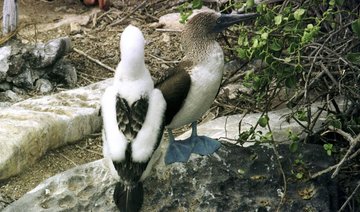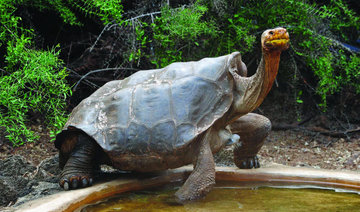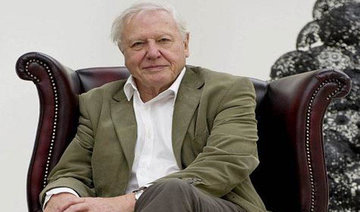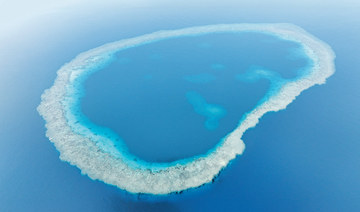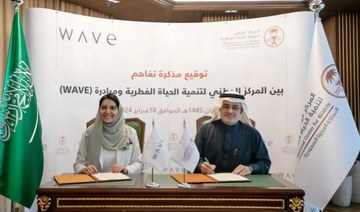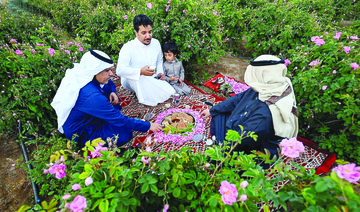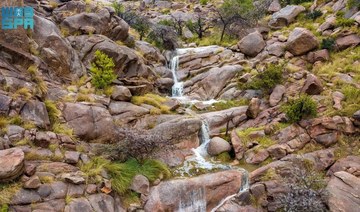PUERTO AYORA, Ecuador: With its iconic giant tortoises, crested black iguanas, huge ocean manta rays and a veritable menagerie of other cool creatures, the Galapagos Islands are one of the most beautiful places you will probably never visit.
Why not? Who wouldn’t want to go to a white sand beach and soak up some sun alongside a lounging iguana, or surf in waters with those lumbering tortoises swimming beside you and a rainbow of tropical fish below?
But in order to protect the flora, fauna and ecosystems of this Pacific archipelago that inspired Charles Darwin’s theory of evolution, Ecuador is in the odd position of having to turn away perhaps millions of would-be tourists each year.
Keeping a tight lid on tourism is the way the South American country has preserved this volcanic string of 19 large islands, dozens of islets and rocky outcroppings.
Authorities wage this fight as world tourism grows and grows — it was up seven percent last year — and they must resist the temptation to let in hordes of visitors, their pockets bulging with dollars.
“The Galapagos are the crown jewel, and as such, we have to protect them,” Tourism Minister Enrique Ponce de Leon said. “We must be drastic in caring for the environment.”
With a network of small hotels and ferries running between the islands, the Galapagos — about 1,000 kilometers off the coast — is an eco-tourism destination that is among the most select spots in all of the Pacific.
Flights from Quito or Guayaquil cost about $400 round-trip, and a one-week stay ranges from $2,000-7,000 per person.
The flow of tourists has risen to 245,000 per year and authorities say that’s pretty much the limit: the maximum the islands can withstand without harming their various ecosystems.
“The environmental, social and biological features of this place — which is like no other — forces us to set a limit, to manage tourism in terms of supply, rather than demand,” said Walter Bustos, director of the Galapagos National Park.
Preyed on in the past by pirates and whaling ships, the Galapagos these days confront illegal fishing, the effects of climate change and the arrival of intrusive species such as dogs, cats and rats brought over from the mainland.
The national park was created in 1959 to protect 97 percent of the islands’ land surface, and in 1978 UNESCO classified the archipelago as a World Heritage Site.
A marine reserve spanning 138,000 square kilometers (53,280 square miles) was also established.
And a 38,000-square-kilometer marine sanctuary in which all fishing is banned was set up between two of the islands, one called Darwin and the other Wolf. Those waters are home to the highest concentration of sharks on Earth.
The islands depend on imports from the mainland and have limited sources of water, so authorities make sure the human population does not grow. These days, only 26,000 people live on the four islands that are in fact inhabited.
By law, Ecuadorans from the mainland are treated as foreigners on the Galapagos. And to obtain permanent residency, such people have to have been married to a local for at least a decade.
For years, the authorities have been limiting construction and promoting the use of renewable energy sources and electric cars. Plastic bags are banned.
On the island of Baltra, which is the main port of entry, the airport runs exclusively on solar and wind power.
“The challenge is to manage tourism in a sustainable way, one that preserves the ecosystems and generates profits. We must not view tourists as the devil,” said Juan Carlos Garcia, conservation director of the World Wildlife Fund in Ecuador.
But of course, limiting tourism here is of no help to the broader Ecuadoran economy, which operates with dollars as the official currency.
And these have been lean years for hard currency in oil-producing Ecuador because of low global crude prices and accumulation of lots of debt. Tourism and mining have emerged as lifesavers.
Last year, visitors to this fabulously diverse country boasting volcanos and thick Amazon jungle shot up 14 percent compared to 2016, totaling 1.6 million. But that is small compared to other countries in Latin America.
President Lenin Moreno’s idea is for tourism is to prop up the economy, even more than oil.
For that reason, he decreed an open-skies policy a few months ago to free up air traffic and bring more tourists to Quito and Guayaquil.
And many of these travelers will want to go to the Galapagos. The state-owned airline TAM has announced more flights to the islands.
Will the island authorities be able to withstand this pressure?
“We need to stress quality, and have those who come now stay longer — have them tour the rest of the country, offering them package deals,” says the tourism minister.
Galapagos fights temptation of lucrative mass tourism
Galapagos fights temptation of lucrative mass tourism
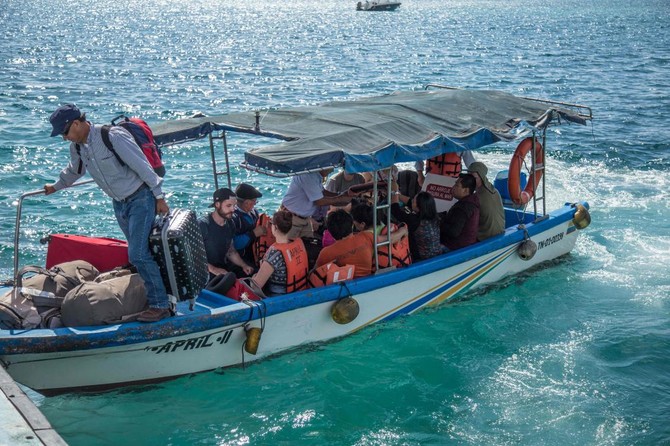
‘Living rocks’ off Saudi Arabia’s Sheybarah Island offer glimpse of how life on Earth began

- Colony of living stromatolites discovered by KAUST team being hailed as a gift to geologists, biologists and environmental scientists
- Geology professor Volker Vahrenkamp had set out to take a closer look at a phenomenon they first spotted on satellite images
LONDON: It was something of an accidental discovery, admits Volker Vahrenkamp with a smile.
“Sometimes, these things need a little luck.”
Vahrenkamp, a professor of geology at King Abdullah University of Science and Technology in Thuwal, on Saudi Arabia’s Red Sea coast, had set out with a team of colleagues to take a closer look at a coastal geological phenomenon they had spotted on satellite images.
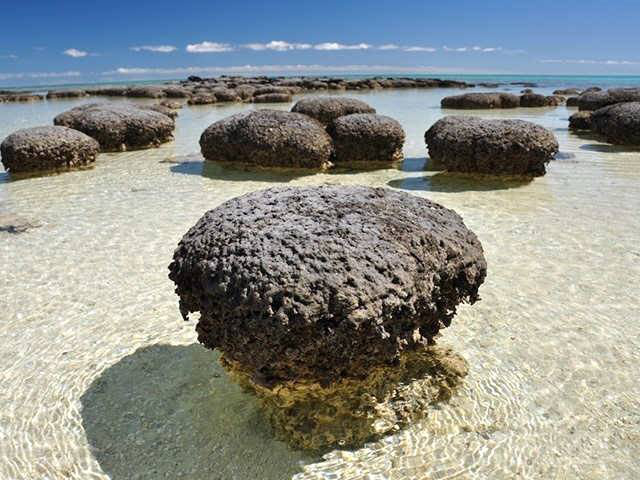
The so-called teepee structures, a tent-shaped buckling of sedimentary deposits found in intertidal zones, are valuable indicators of environmental changes, ancient and modern.
The team was delighted to discover there were examples virtually on their doorstep — just 400 kilometers up the coast from KAUST, off the southern tip of Sheybarah Island, best known for Red Sea Global’s luxury tourism resort of the same name.
“There aren’t really many good examples of teepee structures, where people can study how they form,” Vahrenkamp told Arab News.
“Then we spotted this, and it’s the most spectacular example that I’m aware of.”

The satellite images had shown that there were two teepee fields in the island’s intertidal zone and, after a short boat trip across from the mainland on a converted fishing boat, “we landed on the island, examined one field, and then started walking across to the other.”
And then, as they crossed the foreshore between the two, “we literally stepped on these stromatolites.”
Stromatolites are layered rock-like structures created by tiny microbes, individually invisible to the naked eye, some of which trap sediment in their filaments.
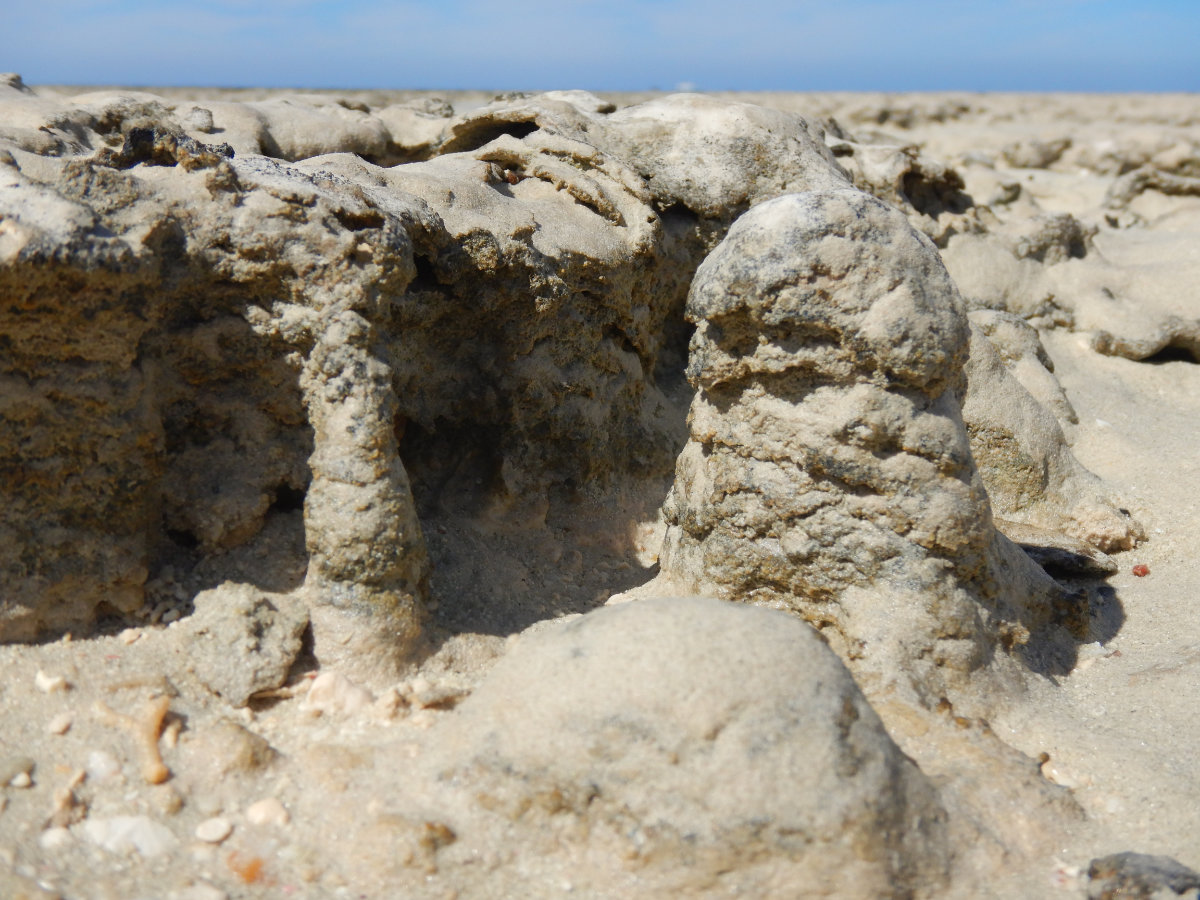
Living on rocks in the intertidal zone, they are covered and uncovered daily by the coming and going of the tides and, in a process known as biomineralization, slowly transform the dissolved minerals and sand grains they capture into a solid mass.
Human beings, and every other living thing on Earth that relies on oxygen to survive, owe their very existence to the tiny, so-called cyanobacteria that have been creating stromatolites for about 3.5 billion years.
Cyanobacteria were one of the first lifeforms on Earth, at a time when the planet’s atmosphere consisted mainly of carbon dioxide and methane. When they emerged about 3.5 billion years ago, they possessed a particular skill — the ability to generate energy from sunlight.
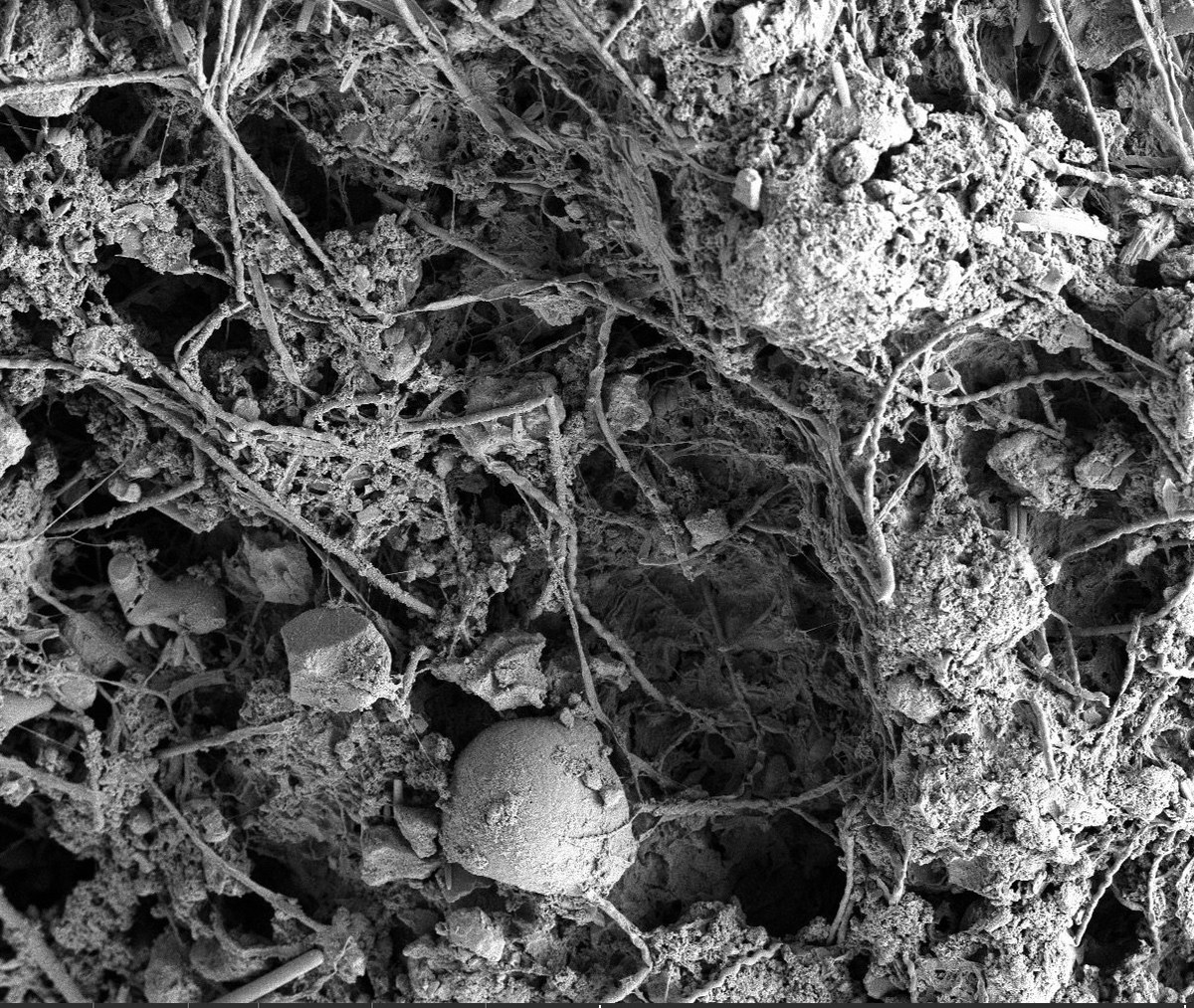
This process, photosynthesis, had a crucial by-product — oxygen. Scientists now believe that the microscopic cyanobacteria were responsible for the biggest thing that ever happened on the planet — the Great Oxidation Event, which saw Earth’s atmosphere transformed and set the scene for the evolution of oxygen-dependent life as we now know it.
Most stromatolites today are merely fossils. As other life on Earth developed, they lost their foothold in the planet’s oceans to competitors, such as coral reefs.

In a few places in the world, however, “modern” living stromatolites, “analogs for their ancient counterparts,” as Vahrenkamp puts it, continue to grow.
“Stromatolites are a vestige of the earliest life on Earth,” he said. “They ruled the Earth for an incredible period of time, about 3 billion years.
“Today they are part of the rock record in many parts of the world, but from these old rocks it is impossible to work out what type of microbes were involved and exactly how they did what they did.”
INNUMBERS
• 400 kilometers Distance of teepee fields from KAUST campus
• 3 billion Years when rock-like stromatolites ruled the Earth
• 120 Meters by which sea level was lower during last Ice Age
That’s why the discovery of a rare colony of living stromatolites, such as the one-off Sheybarah Island, is such a gift to geologists, biologists and environmental scientists.
“When you find a modern example such as this, the chances are that you might be able to better understand how the interaction of this microbial community led to the creation of stromatolites.”
Other examples are known, but they are almost always found in extreme environments, such as alkaline lakes and ultra-saline lagoons, where competitors cannot thrive.
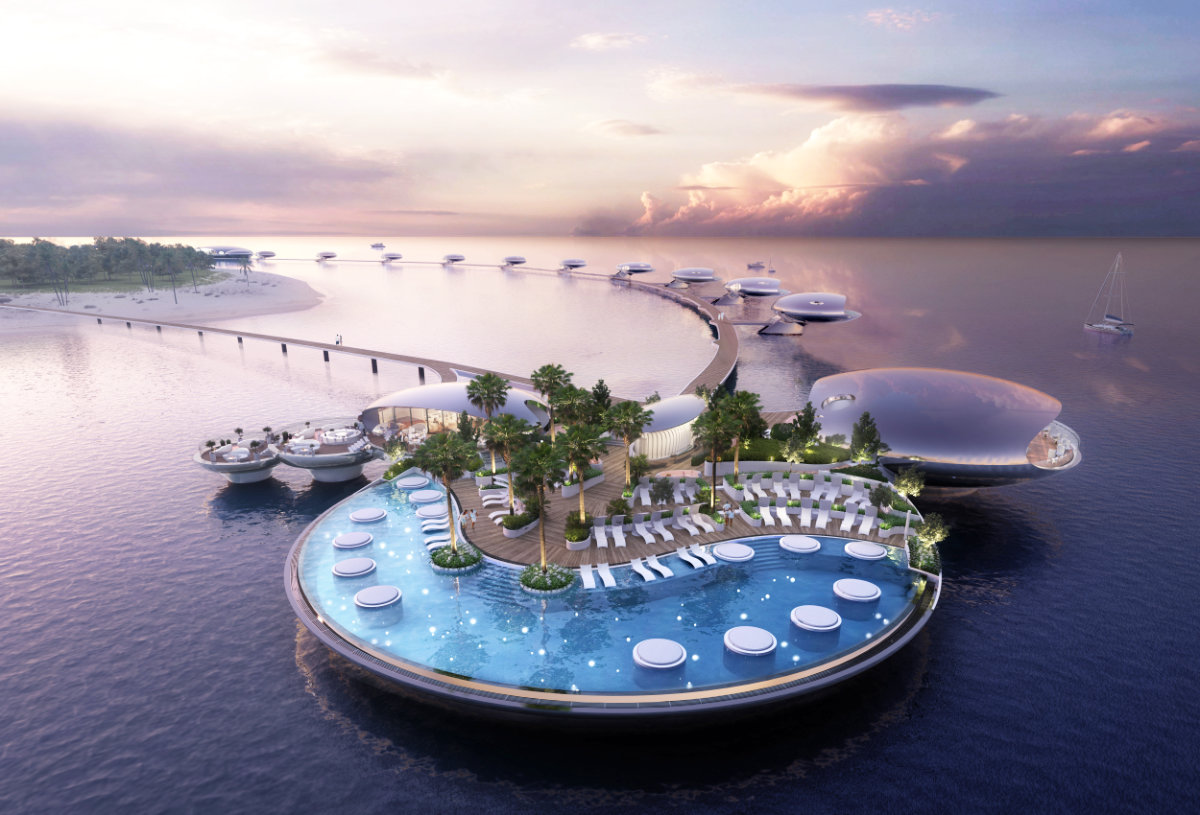
One previous colony has been found in a more normal marine environment, in the Bahamas — which Vahrenkamp has visited, which is why he so readily recognized what he was walking on off Sheybarah Island — but this is the first example of living stromatolites discovered in Saudi waters.
It is not yet clear how old these stromatolites are, “but we can bracket it a little,” said Vahrenkamp.
“We know that during the last Ice Age, the sea level here was 120 meters lower, so they were not there 20,000 years ago. The area where they are was flooded about 8,000 years ago to a height about 2 meters above where it is now, and then the sea level receded again to where it is now about 2,000 years ago.”
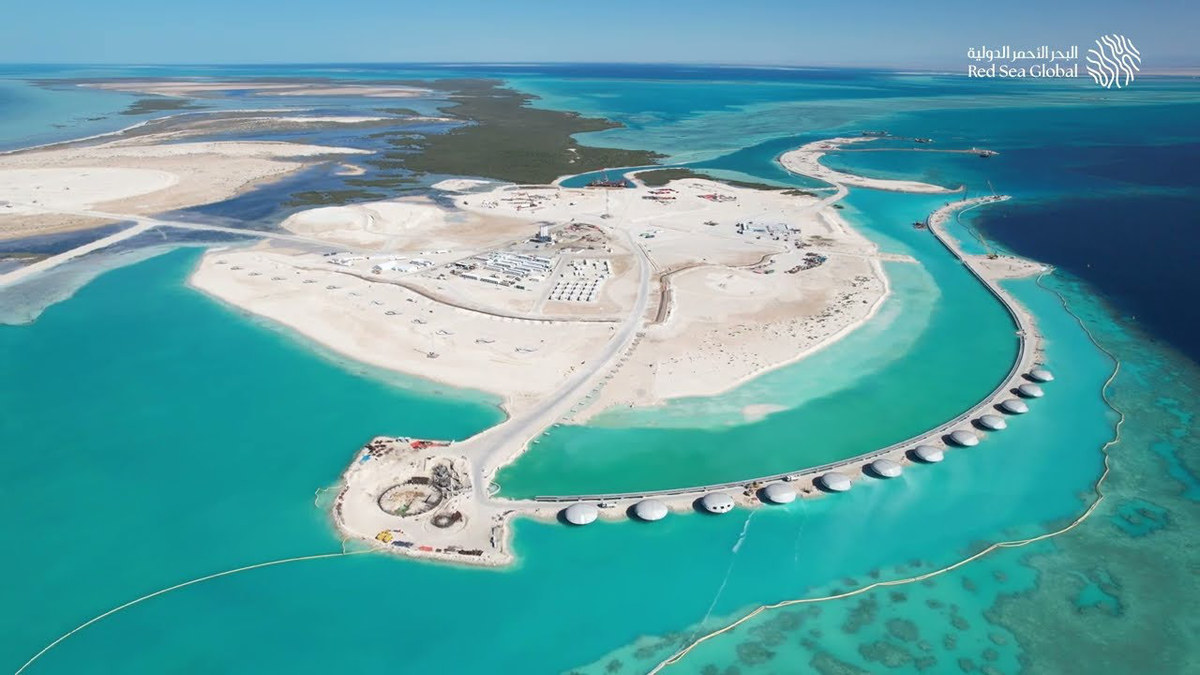
This does not mean the stromatolites are 2,000 years old. No one knows how long it takes the microbes to create their sedimentary layer cake and “no one has yet come up with a good way of dating the layers.
“The tide and the waves come along and throw in sand and material from the surrounding reefs and so all kinds of ages might be present. This makes it very difficult to precisely date the stromatolites and to estimate the growth rate.”
That is why Vahrenkamp and colleagues are now devising an experiment to recreate the natural environment of rising and falling tides and alternating sunlight and darkness in an aquarium, in an effort to grow stromatolites under controlled, easily observable conditions
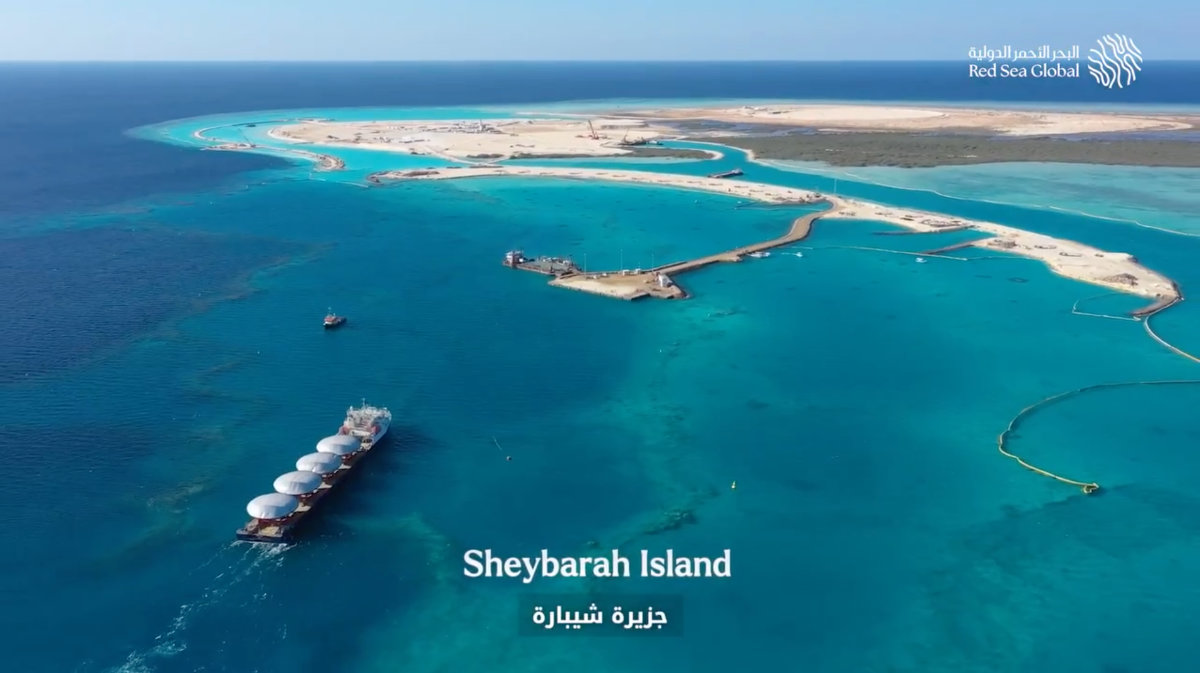
Whether this will take weeks or many years, “we honestly don’t know.”
The team is also working on genetically sequencing many of the thousands of different types of microbial bacteria at work in the stromatolite factory.
“It’s a question of finding out ‘who’ is there, and who’s doing what,” said Vahrenkamp
Opinion
This section contains relevant reference points, placed in (Opinion field)
“But then there is also the question of what kind of functionalities do these bacteria have, and whether we can we use it in other ways, perhaps in medical applications.
“Scientists are now looking intently at the microbial composition of our guts, to find out which microbes cause cancer, for example, and which prevent it. The microbacteria at work in stromatolites could contain functional secrets that we simply are not yet aware of.”
The discovery also has resonance for the environmental ambitions of the Saudi Green Initiative, announced by Crown Prince Mohammed bin Salman in 2021 and which aims, together with the Middle East Green Initiative, to combat climate change through regional cooperation.
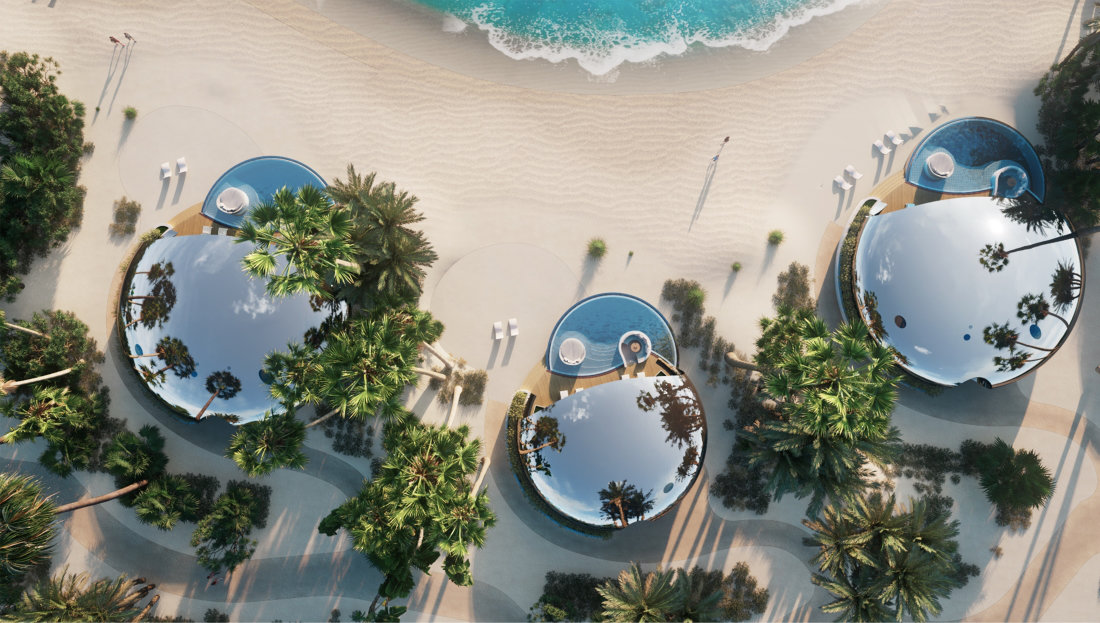
As Vahrenkamp and his seven co-authors wrote in a paper published recently in Geology, the journal of the Geological Society of America, “the discovery of the Sheybarah stromatolite fields holds important implications, not only in the scientific perspective, but also in terms of ecosystem services and environmental heritage awareness in line with the ongoing projects for sustainability and ecotourism development promoted by Saudi Arabia.”
In the paper, the KAUST scientists thank Red Sea Global for its support in accessing the stromatolite site, which is currently being considered for designation as a conservation zone.
As for the tourists relaxing in the spectacular new overwater villas on Sheybarah Island’s crystal-clear Al-Wajh Lagoon, an extra attraction now is that a short stroll along the beach will take them back in time for a glimpse of life on Earth 3.5 billion years ago.

Riyadh conference to explore museum innovation
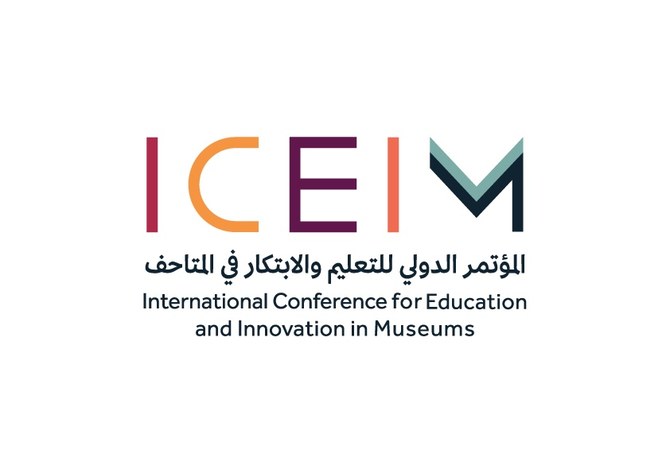
- The winning team will earn a week-long educational trip to London, which will include expert-led museum tours and lectures
RIYADH: Saudi Arabia’s Museums Commission is to host the International Conference on Education and Innovation in Museums, in Riyadh, from June 1 to 3, to help boost the sector in the Kingdom and beyond.
Leading museum professionals and educators will convene for knowledge exchange and collaboration, exploring best practices in museum education; the role of museums in fostering creativity and learning; and opportunities for international collaboration.
The three-day event will feature expert-led sessions, including panel discussions, workshops, and research paper presentations, addressing current museum issues and topics such as collaboration between museums and universities; beyond the textbook for active learning; beyond the museum walls for public engagement; and design thinking and innovation in museum management.
Additionally, the conference will host a competition in which participating teams will develop innovative solutions to enhance visitor engagement and museum experiences.
The winning team will earn a week-long educational trip to London, which will include expert-led museum tours and lectures.
Registration for the competition closes on May 25.
Wildlife center to explore caves in Saudi Arabia’s north

- The program to explore biodiversity in caves was launched “due to its environmental significance and positive impact on wildlife”
RIYADH: Teams from Saudi Arabia’s National Center for Wildlife will begin examining various caves in the Northern Borders region as part of the Caves Exploration Program, which began in 2022.
It comes as part of a larger program that monitors ecosystems and biodiversity throughout the Kingdom.
These sites will be added to an international map of biodiversity and natural heritage hotspots as historical ecosystems and natural biological museums.

Dr. Mohammed Ali Qurban, CEO of the center, explained that the discoveries in the caves hold significant historical environmental value for Saudi Arabia.
“The cave ecosystems serve as a historical museum, providing evidence of the biological diversity that has existed in the Kingdom throughout various historical eras, as well as the spatial, environmental, and climatic changes in the Arabian Peninsula,” he explained.
The cave ecosystems serve as a historical museum, providing evidence of the biological diversity that has existed in the Kingdom throughout various historical eras.
Dr. Mohammed Ali Qurban, National Center for Wildlife CEO
Qurban added that these unique ecosystems provide a suitable environment for a wide range of organisms, as evidenced by the discovery of numerous skeletons of different types of mammals.
The program to explore biodiversity in caves was launched “due to its environmental significance and positive impact on wildlife.”

The center is currently completing studies on the targeted cave sites and documenting their importance within an integrated program.
According to Qurban, the center’s earlier discovery of several Arabian cheetah mummies in a cave in the northern part of the Kingdom — with some skeletons estimated to be over 4,000 years old — provided the first evidence of the species’ presence in the Kingdom.
Consequently, the center plans to develop a program for the resettlement of the Arabian cheetah in the Kingdom, enabling it to play a crucial role in maintaining environmental balance.
Qurban noted that, among other significant discoveries, researchers from the center discovered rare bats and the remains of several extinct animals.
The center is currently working on classifying these finds and determining their ages. This effort will facilitate the resettlement of these extinct species or their closest genetic relatives, thereby restoring their role.
The cave ecosystem is one of the rarest and most important of its kind in the world, recognized as natural heritage by UNESCO.
There are 1,826 caves in the Kingdom, consisting of underground passages and tunnels formed by natural processes in dry limestone areas — evidence of a historical era that experienced prolonged rainy climatic conditions.
Baha’s quaint guesthouses offer a warm welcome

- Sharifa Al-Ghamdi, owner of Al-Ayed Heritage Guesthouse, revealed that she has worked hard over the years to acquire as many historic houses as possible to be able to give tourists an authentic taste of what life was like in the past
RIYADH: Al-Baha is a region of the Kingdom blessed with a rich legacy of ancient architecture, with heritage lodges playing a big role in luring tourism to the city.
According to the Saudi Press Agency, heritage lodges or guesthouses in the region play an important role in attracting more investment. They provide local and international visitors with a look into the past, a taste of a simpler time that many people long for.

The guesthouses are a reflection of the region’s heritage. Al-Baha’s residential buildings, castles and fortresses were designed to suit not just environmental variables such as topography and climate, but also social circumstances such as local customs and ancient traditions.
FASTFACTS
• Heritage lodges or guesthouses in the Baha region play an important role in attracting more investment.
• One of the most enticing elements of these heritage guesthouses is their deep connection with nature.
One of the most enticing elements of these heritage guesthouses is their deep connection with nature.

They are constructed using stones and trees from the region, typically granite and basalt boulders adorned with quartz, and roofed with mud-coated juniper trees.
Sharifa Al-Ghamdi, owner of Al-Ayed Heritage Guesthouse, revealed that she has worked hard over the years to acquire as many historic houses as possible to be able to give tourists an authentic taste of what life was like in the past.

She said that, with the assistance of her family, she was able to realize her lifelong dream and passion and invest her post-retirement time in establishing heritage tourist guesthouses.
She has transformed the old houses in her village from dilapidated structures into a tourist and environmental attraction for people in search of tranquility and relaxation.
All is rosy in Taif as fans flock to flower festival
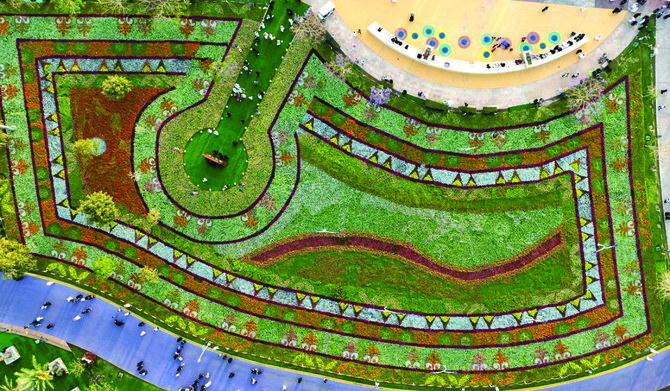
- Taif’s annual show features a floral carpet of over million flowers
- Farmers, vendors optimistic about increase in sales at the event
JEDDAH: Visitors are flocking to the 19th Taif Rose Festival at Al-Raddaf Park where the flowers are in full bloom, highlighting the region’s rich floral heritage.
The festival, themed “Qetaf” meaning “picking time,” coincides with the harvest season and will run until May 12. The organizers include the Taif Rose Cooperative Society and Taif Municipality.

There has been an impressive turnout of Taif residents and domestic and international tourists. The exhibitors — mostly farmers and vendors — are optimistic that increased revenues will help boost rose cultivation and production.
Abdullah Altwairqi, a local farmer and festival participant, said: “Participating in the Taif Rose Festival has become a tradition for me. The atmosphere improves each year, and the revenue and exposure we receive from visitors make it worthwhile.”
HIGHLIGHTS
• Exhibitors at the Taif Rose Festival are optimistic that increased revenues will help boost rose cultivation and production.
• The flower carpet set up by the municipality in the center of the park was designed with decorative patterns inspired by the province’s heritage.
• It covers 5,206 square meters and was crafted using over a million flower and rose seedlings, making it the largest in the history of the festival.
At his booth, Altwairqi showcased various flowers and fruit, including Taif roses, peaches, prickly pears, figs, mulberries, grapes, blackberries, pomegranates, as well as aromatic plants.

Altwairqi urged people to visit the Rose Flavor cafe where they can savor hot and cold beverages infused with the flavor of Taif roses and other aromatic flowers including lavender, which is also abundant in the region.
The flower carpet set up by the municipality in the center of the park left visitors awestruck. Covering 5,206 square meters, it was crafted using over a million flower and rose seedlings, making it the largest in the history of the festival.

Faiz Al-Thibaiti, director-general of media and corporate communication at Taif Municipality, told Arab News: “The flower carpet was designed with decorative patterns inspired by the province’s heritage.”
He said the carpet has ensured the event has become “one of the most important tourism festivals in the Kingdom, attracting thousands of visitors and tourists from various regions of the country.”
NUMBER
70k
The rose-picking season in Taif starts around the end of March or early April, lasting between 35 to 45 days, with an average of 70,000 roses picked daily.
The decorations adorning the flower carpet draw inspiration from the intricate designs found on the walls and facades of Taif’s ancient structures, including Al-Kaki Palace in Al-Salama and King Saud Palace.

Al-Thibaiti added: “Preparations for the festival started early, with the Taif Rose Cooperative Society detailing participation criteria to highlight Taif roses, including their cultivation, harvesting, and distillation into fine perfumes. This adds to Taif’s unique tourist appeal. The festival provides a platform for producers, experts, and entrepreneurs to connect, collaborate, and boost this important sector.”
Among the highlights are the rose and flower path, product stalls, goods market, government booths, and the agricultural nursery.
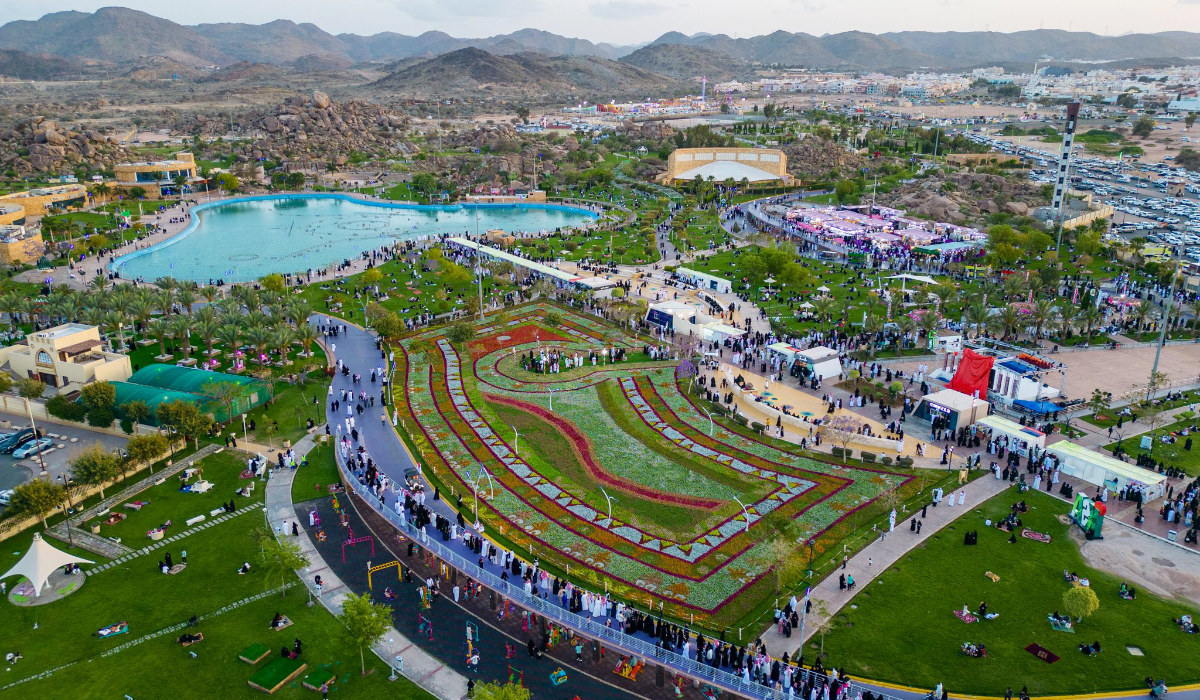
Interactive fountain shows accompanied by national tunes were also among the attractions, with a crossing to the upper pedestrian bridge from where visitors can view the massive flower carpet.
Artwork, flower arrangements, and hanging floral baskets scattered throughout the park added to the flair of the event.

Al-Thibaiti said: “The significant turnout at the current festival comes amid increasing rose production year after year, indicating the success of this agricultural sector in achieving high revenues while continuing to promote the Taif rose product.”
Taifrosethon
The five-day Taifrosethon began on May 7, which is being held to encourage entrepreneurship in the region with technological solutions to enrich the industry.
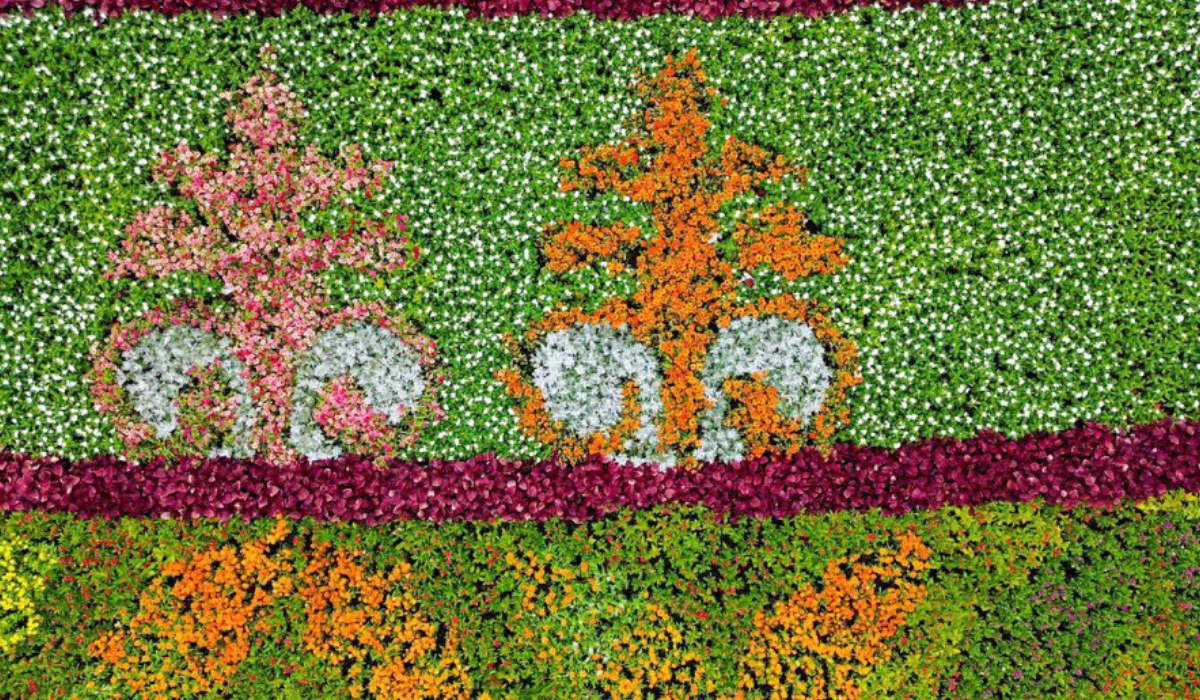
The event includes various skills training and technical workshops covering trade, cultural heritage, and tourism.
The top-three winners will receive $2,666, $1,866 and $1,333 respectively. Participants are required to enter as teams, each with three to five members.
Taif’s roses
The Taif province produces more than 200 million roses each season. According to the local chamber of industry, each tree produces an average of 250 roses daily throughout the harvest season, which lasts for about 45 days.
The rose-picking season starts around the end of March or early April, lasting between 35 to 45 days, with an average of 70,000 roses picked daily.
Taif roses feature an exquisite, sweet fragrance and vibrant pink hues on delicate petals, and are a hallmark of the region’s natural beauty.
Cultivated in the high-altitude climate of Taif, these roses thrive in the cool temperatures and fertile soil of the region.
They are meticulously harvested by hand to preserve their quality, with the petals carefully collected for various purposes.




